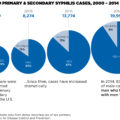Precum is a pre-ejaculate fluid that is discharged from a penis when it’s aroused and usually occurs right before ejaculation. The fluid acts as a natural lubricant during sex. Precum is something you may want to know more about, especially if you are planning a pregnancy or are worried about HIV and STIs.
Even though precum fluid comes from the ‘Cowpers gland’ (and not from testes like semen), some fluid can contain live sperm. A number of researchers believe this is a ‘cross-contamination’ from semen that may be present in the urethra from a previous sexual encounter, as both the pre-ejaculate fluid and semen pass through the urethra. Although the chances of pregnancy from pre-ejaculate fluid is relatively low and can vary from person to person, 27% of those who use withdrawal as a regular form of contraception end up with a pregnancy. One 2008 study estimates that 18 percent of couples who use the withdrawal method will become pregnant in a year. According to a 2013 National Health Statistics, about 60 percent of women in the United States report using this birth control option.
Can Precum Transmit STDs, Including HIV?
Sexually transmitted diseases (STDs) are infections that can be transferred from one person to another through any type of sexual contact. STDs are sometimes referred to as sexually transmitted infections (STIs) since they involve the transmission of a disease-causing organism from one person to another during sexual activity. It is important to realize that sexual contact includes more than just sexual intercourse (vaginal and anal). Sexual contact includes kissing, oral-genital contact, and the use of sexual “toys,” such as vibrators. STDs probably have been around for thousands of years, but the most dangerous of these conditions, the acquired immunodeficiency syndrome (AIDS or HIV disease), has only been recognized since 1984.
Many STDs are treatable, but effective cures are lacking for others, such as HIV, HPV, and hepatitis B, and hepatitis C. Even gonorrhea, once easily cured, has become resistant to many of the older traditional antibiotics. Many STDs can be present in, and spread by, people who do not have any symptoms of the condition and have not yet been diagnosed with an STD. Therefore, public awareness and education about these infections and the methods of preventing them is important.
There really is no such thing as “safe” sex. The only truly effective way to prevent STDs is abstinence. Sex in the context of a monogamous relationship wherein neither party is infected with an STD also is considered “safe.” Most people think that kissing is a safe activity. But unfortunately, syphilis, herpes, and other infections can be contracted through this relatively simple and apparently harmless act. All other forms of sexual contact carry some risk. Condoms are commonly thought to protect against STDs. Condoms are useful in decreasing the spread of certain infections, such as chlamydia and gonorrhea; however, they do not fully protect against other infections such as genital herpes, genital warts, syphilis, and AIDS. Prevention of the spread of STDs is dependent upon the counseling of at-risk individuals and the early diagnosis and treatment of infections.
Precum fluid can carry bacteria and viruses. Using the withdrawal method will not protect you from STIs, including HIV. If you are unsure of your partners’ status, consider another form of contraception. So if you want to reduce the risk of STIs and HIV, and you’re not planning a pregnancy, you may want to use alternative contraception methods like the male condom. READ: Is Blue Waffle Disease Real
How Much Precum Is Needed To Transmit HIV?
HIV can be transmitted via the exchange of a variety of body fluids from infected people, such as blood, breast milk, semen, precum, and vaginal secretions. HIV can be detected in the semen of men who have an undetectable viral load in blood, according to the results of a 304-man study. This finding underlines the importance of using condoms when having sex, even if a man is taking antiretroviral therapy and has an undetectable viral load in blood. If HIV can be detected in semen – even at low levels there may be a chance that it can be transmitted to a female or male sex partner.
Several studies show that sex partners of HIV-positive people taking antiretrovirals have a lower risk of becoming infected with HIV than do partners of people not taking antiretrovirals. As a result, some HIV experts and public health officials believe everyone with HIV should start antiretroviral therapy as a way to prevent the spread of HIV. U.S. antiretroviral guidelines say everyone with HIV should start antiretroviral therapy, regardless of CD4 count.
A new study reports that fibers a component found in semen can enhance HIV transmission by as much as 100,000-fold, researchers have found. The results, if verified in a clinical setting, could identify a new way to help prevent the spread of the disease. The composition of the precum is similar to semen, the presence of sperms in the pre-ejaculate is quite variable among normal men. Irrespective of quantity, Multiple studies have revealed the presence of HIV in most pre-ejaculate samples of HIV-positive individuals. SEE: Shower After Sex Reduce STD – New Study





